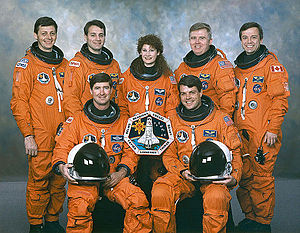STS-78
Lua error in package.lua at line 80: module 'strict' not found.

Columbia launches on mission STS-78
|
|||||
| Mission type | Bioscience research Microgravity research |
||||
|---|---|---|---|---|---|
| Operator | NASA | ||||
| COSPAR ID | 1996-036A | ||||
| SATCAT № | 23931 | ||||
| Mission duration | 16 days, 21 hours, 48 minutes, 30 seconds | ||||
| Distance travelled | 11,000,000 kilometres (6,800,000 mi) | ||||
| Orbits completed | 271 | ||||
| Spacecraft properties | |||||
| Spacecraft | Space Shuttle Columbia | ||||
| Payload mass | 9,649 kilograms (21,272 lb) | ||||
| Crew | |||||
| Crew size | 7 | ||||
| Members | Terence T. Henricks Kevin R. Kregel Richard M. Linnehan Susan J. Helms Charles E. Brady, Jr. Jean-Jacques Favier Robert Brent Thirsk |
||||
| Start of mission | |||||
| Launch date | 20 June 1996, 14:49:00.0075 UTC | ||||
| Launch site | Kennedy LC-39B | ||||
| End of mission | |||||
| Landing date | 7 July 1996, 12:37:30 UTC | ||||
| Landing site | Kennedy SLF Runway 33 | ||||
| Orbital parameters | |||||
| Reference system | Geocentric | ||||
| Regime | Low Earth | ||||
| Perigee | 246 kilometres (153 mi) | ||||
| Apogee | 261 kilometres (162 mi) | ||||
| Inclination | 39.0 degrees | ||||
| Period | 89.6 minutes | ||||

|
|||||
STS-78 was the fifth dedicated Life and Microgravity Spacelab mission for the Space Shuttle program, flown partly in preparation for the International Space Station project. The mission used the Space Shuttle Columbia, which lifted off successfully from Kennedy Space Center’s launch pad 39-B on 20 June 1996.
Contents
Crew
| Position | Astronaut | |
|---|---|---|
| Commander | Fourth spaceflight |
|
| Pilot | Second spaceflight |
|
| Mission Specialist 1 | First spaceflight |
|
| Mission Specialist 2 | Third spaceflight |
|
| Mission Specialist 3 | First spaceflight |
|
| Payload Specialist 1 | Only spaceflight |
|
| Payload Specialist 2 | First spaceflight |
|
Backup crew
| Position | Astronaut | |
|---|---|---|
| Payload Specialist 1 | First spaceflight |
|
| Payload Specialist 2 | First spaceflight |
|
Mission objectives
- Research into the effects of long – duration spaceflight on human physiology in preparation for flights on the International Space Station.
- 22 life science & microgravity experiments using the Orbiter’s pressurised Life & Microgravity Spacelab module (LM2).
- Tests into the use of the Orbiter’s Reaction Control System jets to raise the altitude of orbiting satellites.
Mission highlights
During the 16-day, 21-hour mission, the crew of Columbia assisted in the preparations for the International Space Station by studying the effects of long-duration spaceflight on the human body in readiness for ISS Expeditions, and also carried out experiments similar to those now being carried out on the orbital station.
Following launch, Columbia climbed to an altitude of 278 kilometers (173 mi) with an orbital inclination of 39° to the Earth's equator to allow the seven-member flight crew to maintain the same sleep rhythms they were accustomed to on Earth and to reduce vibrations and directional forces that could have affected on-board microgravity experiments.
Once in orbit, the crew entered the 40 foot (13 m) long pressurised Spacelab module to commence over 40 science experiments to take place during the mission. Not only did these experiments make use of the module’s laboratory, but also employed lockers in the middeck section of the Shuttle. Thirteen of the experiments were dedicated to studying the effects of microgravity on the human body, whilst another six studied the behaviour of fluids and metals in the almost weightless environment and the production of metallic alloys and protein crystals. The crew also carried out the first ever comprehensive study of sleep patterns in microgravity, research into bone and muscle loss in space, and in-flight fixes to problem hardware on the Bubble, Drop and Particle Unit (BDPU), designed to study fluid physics.
The mission also featured a test of a procedure that was later used during the second Hubble Space Telescope servicing mission to raise the telescope’s altitude without damaging the satellite’s solar arrays. During the test, Columbia’s vernier Reaction Control System jets were gently pulsed to boost the Shuttle's altitude without jarring any of the mission payloads. The test was successful, and was later employed by Discovery during STS-82, and was used multiple times to boost the orbit of the ISS during visits by Shuttles.
The mission encountered no significant in-flight problems, was the 78th Space Shuttle mission, and the 20th mission for Columbia.
See also
- Space science
- Space shuttle
- List of space shuttle missions
- List of human spaceflights chronologically
External links
![]() This article incorporates public domain material from websites or documents of the National Aeronautics and Space Administration.
This article incorporates public domain material from websites or documents of the National Aeronautics and Space Administration.
